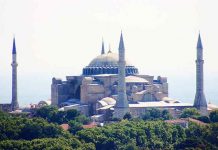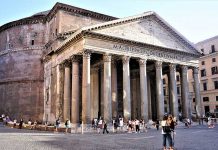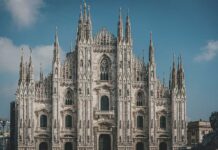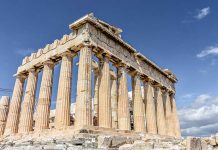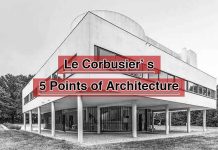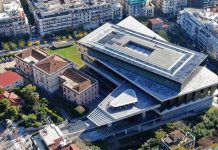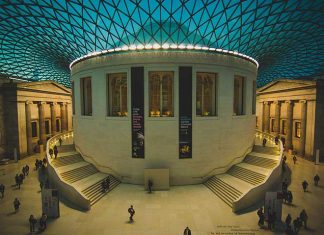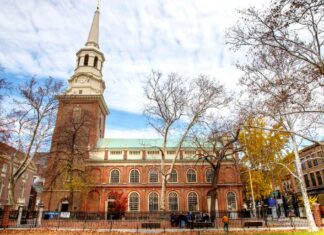Baroque architecture is a highly ornate, theatrical and dramatical architectural style that emerged in the late-16th century in Europe. This fancy style is famous for its ornamental decoration, grandeur and monumentality. It is often associated with the Catholic Church, which was a major sponsor of art movements in Europe during this period.
The Baroque-style architecture was so influential. Even today, you can see many European buildings have key features of Baroque architecture, such as the use of light and shadow to create dramatic effects, illusionistic elements, oval shapes and curve lines, as well as convex and concave facades.
In this article, we’ll talk about the history and key features of the Baroque architecture style, and learn about the most famous architects in the Baroque period like Gian Lorenzo Bernini and Francesco Borromini.
Moreover, we’ll overview some notable Baroque buildings, including St. Peter’s Basilica in Rome, the Palace of Versailles in Paris and Schönburn Palace in Austria.
Let’s start with the historical process of the style.
History of Baroque Style Architecture

The Baroque movement, one of the most important styles of European architectural history, stands out in art fields such as architecture, music, theatre, literature and painting. It developed and spread mostly between the 16th and 18th centuries.
Italy, the homeland of Renaissance architecture, is also the birthplace of Baroque-style architecture dating back to the last quarter of the 16th century.
The movement has spread to Europe from there. Then, has decorated important palaces, cathedrals, churches, and luxury houses in Europe for about 200 years.
What was the purpose of Baroque?
We know that architecture had a propaganda function throughout history. Power elites have used architecture as a propaganda tool to control and direct perceptions of people in the fields of religion, politics, industry, etc. many times.
The first examples of Italian Baroque architecture have been designed in Rome with the aim of attracting people to the Catholic doctrine.
Shaped around religious purposes, Baroque buildings had interior walls and ceilings that include pictures with biblical quotations. Thus, the church helped people, who can’t read the Bible, understand the Bible through Baroque architecture.

This action of the Catholic Church in the field of arts was a counter-reformation to the Protestant doctrine. Reformists like Martin Luther criticized such kinds of acts that the church did to get financial power. In this line, an opposition movement emerged, getting popularized day by day against the church.
Following these developments, the Papacy understood punishing people heavily at the indulgence courts was wrong. Because this would cause to make people pulling away from the church and harm its image.
Apart from religious buildings, it was also used in secular structures, such as palaces and government buildings. Designed in the Baroque style, these buildings was showcasing the wealth and power of the ruling classes.
The End of the Baroque Period
Some people identify late-period Baroque with Rococo architecture. Whatever the name, this is the end of an important adventure in every sense.
Starting with the classical period and continuing to shape the world with styles such as Renaissance and Gothic, which are great art movements of the West, it ended with Baroque and Rococo.
There are several reasons behind this ending. For example, the liberty movement that the French Revolution bring, the downturn of the agriculture-based economies caused by the development of industries, and the fact that the world was getting more modern and rational can be counted among these reasons.
Moreover, the world tended to be more and more globalized in that period. Train lines and bridges, which are designed much more with rational solutions thanks to engineering science, had a great impact on the architecture field.
In that new world, people didn’t think much that what kinds of styles they should design their structures with anymore.
In addition, the function began to come to the fore as much as decoration as a result of new adoptions like the use of materials such as iron and steel in the construction sector.
Eventually, all of these developments and innovations caused the closing of the era of great movements, and they paved the way for modern architecture.
As a result, pioneers of the Catholic sect started a Catholic revival to attract people again to their churches. And Baroque-style architecture was the key to this holy purpose.
Baroque Architecture Characteristics
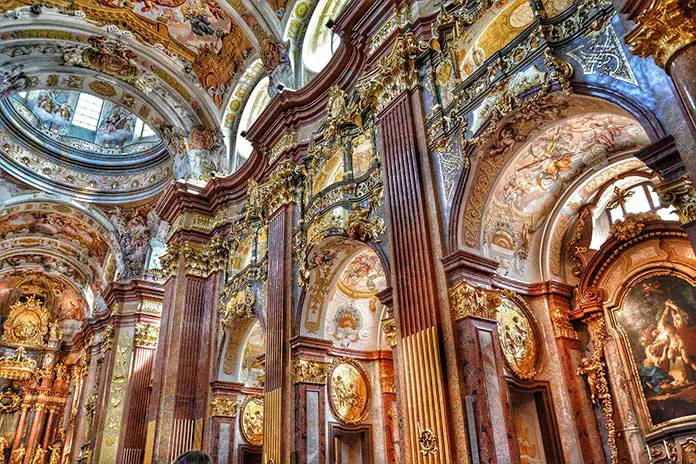
Born as a reaction to the rule-based, disciplined, rational and logical approach of the Renaissance, Baroque architecture is known for its dynamic, enthusiastic and sentimental attitude. Baroque period buildings are incredibly magnificent and ostentatious.
This exciting style has come to the forefront in building types such as churches and palaces. Because such places demonstrate the religious and authoritarian forces’ shows of strength.
The architecture of the Baroque period has continued to use both essential rules of the classic era and the most important elements of classical orders. However, it has also brought more free and imaginative expressions to the fore.
In the Baroque era, Architects used classical columns, friezes, pediments, domes, pilasters and many other architectural elements away from their usual forms.
They also used architecture, sculpture, painting and other plastic arts together to impress people with the magnificence and enthusiasm of Baroque buildings.
Now, let’s look at the main characteristics of the Baroque style architecture.
Key Features of Baroque Style in Architecture
- Emphasized adornments with oval shapes, also curve lines
- Walls designed in curved and dynamic forms
- Grandiose gardens
- Improving the spiritual impacts of paintings
- Use of light and shadow to create dramatic effects
- Dramatical drawings adorning walls and ceilings, handling religious subjects, and orienting perception with optical illusions
- The blending of sculptures and paintings
- Ceilings and walls with gold leafs
- Convex and concave facades
- Use of classical elements like columns and pediments, often exaggerated and highly ornamented
- Architectural elements that are unfinished or not completed wittingly
Overall, Baroque architecture is a highly ornate and dramatic style that is characterized by its optical illusions, use of light and shadow, ornamentation and curved forms.
Additionally, domes, spiral pillars, and plague pillars that are dedicated to the end of the plague pandemic, as well as medallion-type and oval-formed wide staircase ladings are some key elements of Baroque architecture.
Famous Architects of Baroque Architectural Style
Baroque architecture was developed by a great number of gifted architects. Many of them are still remembered for their contributions to this style. Here are some of the most famous Baroque architects:
- Francesco Borromini
- Gian Lorenzo Bernini
- João Antunes
- Elias Holl
- Christopher Wren
- Louis Le Vau
- Baldassare Longhena
- Johann Bernhard Fischer von Erlach
- Salomon de Brosse
- Johann Lucas von Hildebrandt
- Cristoph Dientzenhofer
- Dominikus Zimmermann
- Francesco Bartolomeo Rastrelli
1. Gian Lorenzo Bernini
| Born and death years: | 1598-1680 |
| Birthplace: | Naples, Italy |
| Famous works: | David, Apollo and Daphne, Piazza San Pietro |
Born in 1598 in Naples, Italy, Bernini was an Italian architect, sculptor, and painter who is widely regarded as one of the greatest artists of the Baroque period.
There are many famous paintings by Gian Lorenzo Bernini, such as Apollo and Daphne, David, Ecstasy of Saint Teresa and Rape of Proserpina.
Moreover, he designed several iconic buildings, including the colonnade in front of St. Peter’s Basilica in Rome, which is considered a masterpiece of Baroque architecture. He also took over the construction of Palazzo Barberini after Carlo Maderno’s death.
Important works of Gian Lorenzo Bernini:
- Piazza San Pietro in Vatican City, Italy (1656–67)
- Sant’Andrea al Quirinale in Rome, Italy (1658-1670)
- San Tommaso da Villanova in Castello, Italy (1658–1661)
- Santa Maria Assunta in Ariccia, Italy (1662–1664)
2. Francesco Borromini
| Born and death years: | 1591-1667 |
| Birthplace: | Bissone, Switzerland |
| Famous works: | San Carlo alle Quattro Fontane, Sant’Agnese in Agone, Sant’Ivo alla Sapienza |
Borromini was an Italian architect who worked in Rome during the Baroque period. He was known for his innovative use of geometric shapes.
He was born in Bissone, a canton in Old Swiss Confederacy, and moved to Rome in 1616. There, he worked with Carlo Maderno on different projects such as St. Peter’s and Palazzo Barberini.
One of his most famous works is the Church of San Carlo alle Quattro Fontane (San Carlino), constructed in 1938-1941 in Rome. There are also some buildings where Borromini worked with other architects collaboratively, including Sant’Agnese in Agone in Rome.
Important works of Francesco Borromini :
- Church of San Carlo alle Quattro Fontane in Rome (1638-1641)
- Oratory of Saint Philip Neri in Rome (1637-1650)
- Sant’Ivo alla Sapienza in Rome (1642-1660)
- Sant’Agnese in Agone in Rome (1652-1859)
- The Re Magi Chapel of the Propaganda Fide in Rome (1660-1665)
Borromini also held many restoration projects in his career. Santa Lucia in Selci and San Giovanni in Oleo are among these buildings, which were restored by Francesco Borromini.
3. Christopher Wren
| Born and death years: | 1632-1723 |
| Birthplace: | Wiltshire, England |
| Famous works: | St. Paul’s Cathedral |
Sir Christopher Wren was an English architect who is known for famous buildings in the English Baroque style. He was also an anatomist, astronomer and mathematician.
Due to the Great Fire of London in 1666, many churches in the city were destroyed. Christopher Wren was commissioned to rebuild 52 of these churches. When he was appointed to this job, Wren was only 33 years old.
One of these 52 churches he rebuilt is St. Paul’s Cathedral in London, which is among the most iconic buildings in the city. It’s also a unique example of English Baroque architecture.
Important works of Christopher Wren:
- Pembroke College Chapel in Cambridge (1663–65)
- Sheldonian Theatre in Oxford (1664–69)
- St Lawrence Jewry London (1670-86)
- St. Paul’s Cathedral in London (1675-1710)
- Wren Library in Cambridge (1676-95)
- The Church of St. Andrew in London (1686-87)
- Greenwich Hospital in London (1699-1750)
4. Johann Bernhard Fischer von Erlach
| Born and death years: | 1656-1723 |
| Birthplace: | Graz, Austria |
| Famous works: | Schönbrunn Palace, Karlskirche |
Fischer von Erlach was an Austrian architect, sculptor, engraver, and architectural historian. He also wrote a book A Plan of Civil and Historical Architecture in 1721.
Johann Bernhard Fischer von Erlach is known for his famous work Karlskirche in Vienna, which is considered one of the most important examples of Baroque architecture in Austria. The building is also called the Church of St. Charles.
In the design of Karlskirche, he aimed to incorporate the ideas and principle elements of the most influential churches in history, including the Temple of Solomon, Hagia Sophia, Pantheon and Saint Peter’s Basilica, the Dome des Invalides and Saint Paul’s Cathedral.
Important works of Johann Bernhard Fischer von Erlach:
- Schönbrunn Palace in Vienna, Austria (1695-1711)
- Schloss Neuwaldegg in Vienna, Austria (1692-97)
- Winter Palace of Prince Eugene in Vienna, Austria (1695–97)
- Holy Trinity Church in Salzburg, Austria (1694–1702)
- Palais Trautson in Vienna, Austria (1710–12)
- Stallburg in Vienna, Austria (1723)
- Karlskirche in Vienna, Austria (1716–23)
5. Francesco Bartolomeo Rastrelli
| Born and death years: | 1700-1771 |
| Birthplace: | Paris, France |
| Famous works: | Catherine Palace |
Russian architect Francesco Bartolomeo Rastrelli was among the pioneers of the Elizabethan Baroque style, which is also known as Russian Baroque architecture. Mostly located in Russia, His works are ostentatious and majestic examples of Late Baroque architecture.
His notable structure Winter Palace in St. Petersburg is one of the most famous Baroque buildings in Russia. While he mostly designed palaces, there are also some religious structures designed by Rastrelli, such as Saint Andrew’s Church in Kyiv, Ukraine.
Important works of Bartolomeo Rastrelli:
- Peterhof Palace in St. Petersburg, Russia (1747-55)
- Saint Andrew’s Church in Kyiv, Ukraine (1748-67)
- Smolny Convent in St. Petersburg, Russia (1748-64)
- Vorontsov Palace in St. Petersburg, Russia (1749-57)
- Catherine Palace in Pushkin, Russia (1749)
- Stroganov Palace in St. Petersburg, Russia (1754-54)
- Winter Palace in St. Petersburg, Russia (1754-62)
Baroque Architecture Examples
1. Church of Gesu
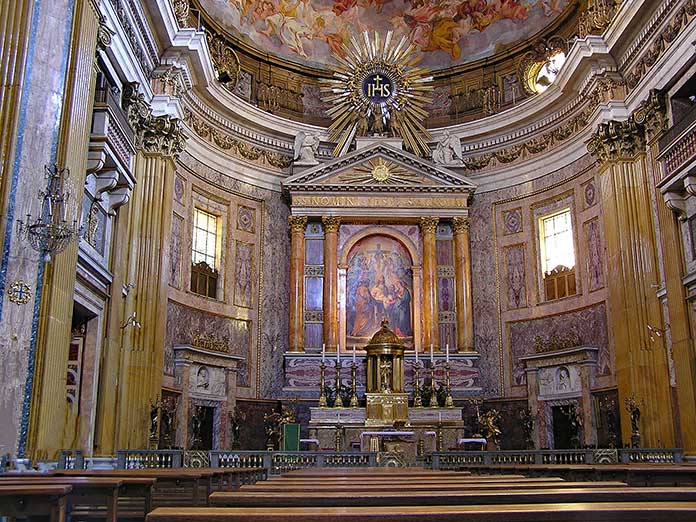
- Architects: Giacomo Barozzi da Vignola, Giacomo della Porta
- Location: Rome, Italy
- Construction years: 1568
- Style: Baroque architecture, Mannerism
The church of Gesu, designed by Giacomo Barozzi da Vignola and Giacomo della Porta in 1568-1580, is the first known example of Baroque architecture. The design of its front facade is considered to be the beginning of Baroque architecture.
Located in the Piazza del Gesù in Rome, the church includes some characteristics of the Late Renaissance as well. It has a single nave to ensure the sermon is heard clearly. It has also a huge Renaissance-style dome.
The facade, designed by Giacomo della Porta, features triangle pediments, acanthus leaves, pilasters, two papal coats of arms, medallions, tympanums and statues.
The interior design is so ornamented. The most important work inside is the ceiling fresco, Triumph of the Name of Jesus by Giovanni Battista Gaulli.
The church is comparatively smaller than other renowned Baroque architecture examples, with its dimensions of 75 m (246 ft) by 35 m (82 ft). However, it has a very important place in the history of the Baroque style.
2. Versailles Palace

- Architect: Louis Le Vau, André Le Nôtre, Jules Hardouin-Mansart
- Location: Paris, France
- Construction years: 1634-1661
- Style: Baroque architecture
This palace represents the power of the French royal family. Versailles, designed in the 17th century, is perhaps the most popular and magnificent one among the Baroque buildings.
The palace was the former royal residence of the French Empire. It has grandiose French Baroque gardens designed by André Le Nôtre. The symmetrical garden includes immersive landscape elements, artificial lakes, fountains, and statues, emphasizing oval Baroque forms.
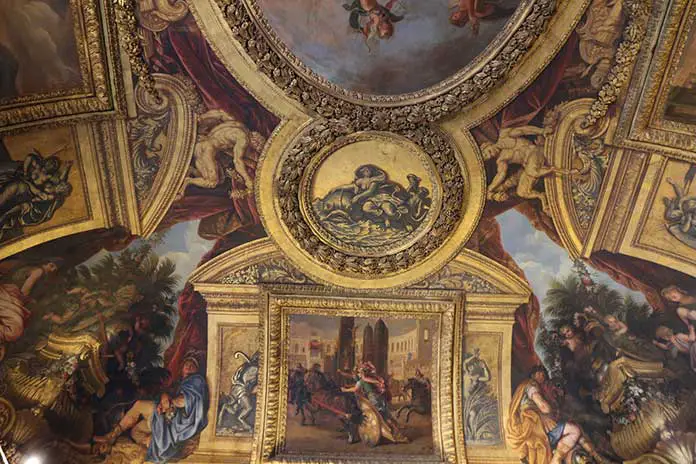
Interior spaces feature elaborate ornaments from top to bottom. There are some famous rooms inside, such as the Hall of Mirrors designed in 1678–89. There are 17 arched mirrors in the gallery and the hall extends over 70 m (230 ft).
Designed by the contributions of many architects, the palace is among the most visited landmarks of Paris.
3. St. Peter’s Basilica
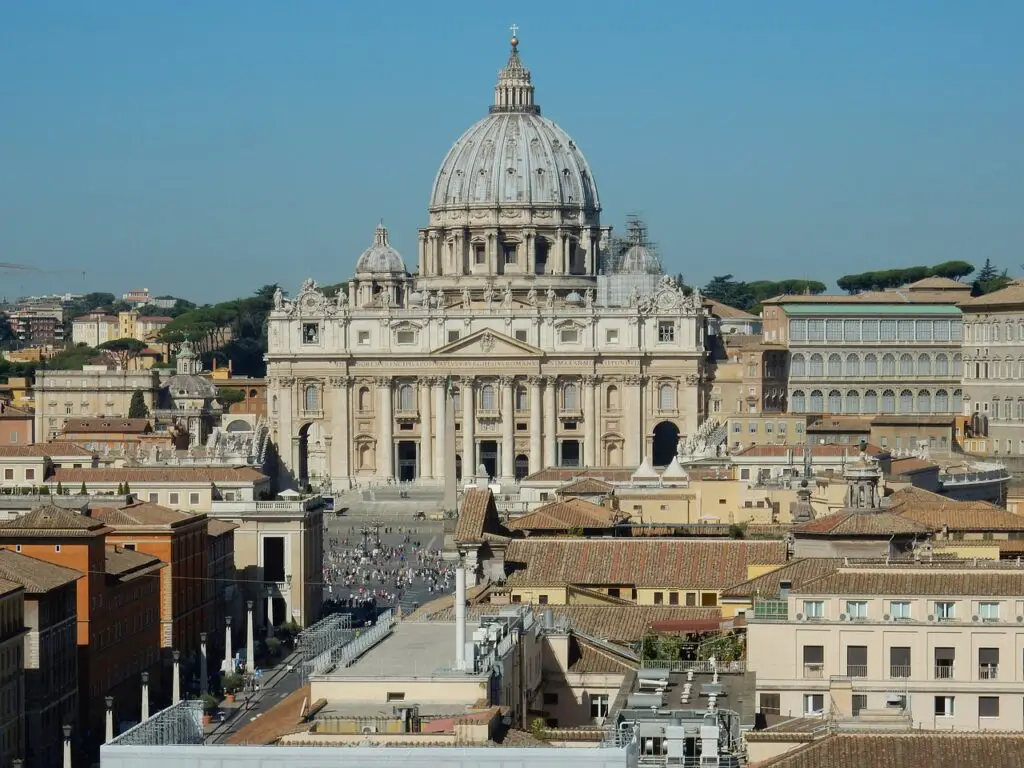
- Architect: Donato Bramante, Michelangelo, Gian Lorenzo Bernini, and more
- Location: Vatican City, Italy
- Construction: 1506-1626
- Style: Renaissance architecture, Baroque architecture
This basilica, located in the Vatican City, is quite important for Catholics. It’s regarded as the center for the sect and the biggest church of Christians. Not only tourists but also religious people who want to make their worship come here from the entire world every year.
Michelangelo, a famous Renaissance architect and artist, worked in the construction of St. Peter’s Church. However, when he died, the progress of the construction was stopped.
After many other architects worked here, the new pope Sixtus V. wanted Gian Lorenzo Bernini to design the square at the front of St. Peter’s Basilica and continue the construction.
While many different architects contributed to the building’s architecture, the main principles of design were shaped by Donato Bramante, Michelangelo, Carlo Maderno and Gian Lorenzo Bernini.
Consequently, the building’s construction started in 1506 and was completed in 1626.
4. Saint Peter’s Square
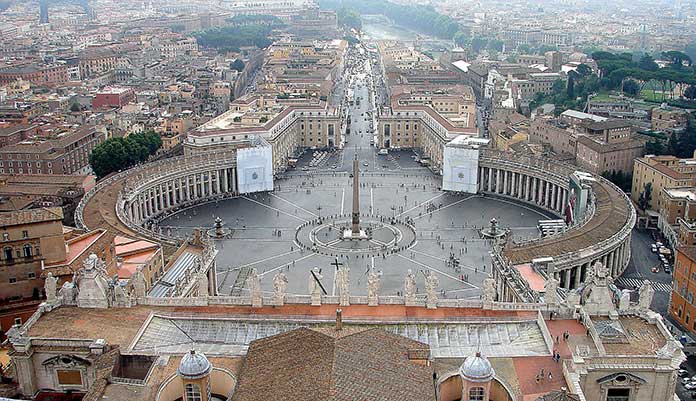
- Architect: Gian Lorenzo Bernini
- Location: Vatican City
- Construction: 1656-1667
- Style: Baroque architecture
The square, designed by Bernini, is located in front of St. Peter’s Basilica in Vatican City. Christians visit here to receive the prayer of the pope. This place is an extremely important religious center, with 284 Doric columns.
Except for colonnades, there are some other designs here, such as a fountain designed by Carlo Maderno and an Egyptian obelisk gathered from Egypt in 1586. There is also a granite fountain designed by Bernini in 1613.
5. St. Paul Cathedral
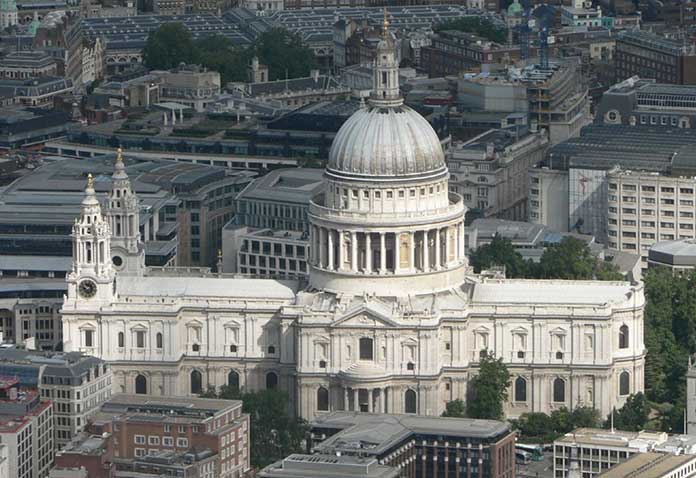
- Architect: Sir Christopher Wren
- Location: Londra, England
- Construction: 1675-1710
- Style: English Baroque architecture
Sir Arthur Christopher Wren designed this building in Londra in 1675-1710. Saint Paul Cathedral is among the most important examples of English Baroque architecture.
The Baroque architectural style developed slower in northern Europe countries. Additionally, less magnificent buildings were designed there. For that reason, you can easily recognize that St. Paul’s Cathedral is less extravagantly compared to examples of French and Italian Baroque architecture.
Other famous examples of Baroque architecture style:
- San Carlo alle Quattro Fontane
- St. Nicolas Church
- Madrid Royal Palace
- La Granja Palace
- Karlskirche
- Schönbrunn Palace
- Winter Palace
Final Thoughts on Baroque Architecture
In conclusion, Baroque is a highly ornate and dramatic architectural style that emerged in Italy in the late 16th century. It spread in Europe between the 16th and 18th centuries.
The style is known for its grandeur and luxury ornamentations, as well as its use of light and shadow to create dramatic illusions.
Some of the most famous Baroque architects, including Gian Lorenzo Bernini, Francesco Borromini, Christopher Wren, Johann Bernhard Fischer von Erlach and Bartolomeo Rastrelli, designed considerable buildings that defined this style.
These buildings, such as St. Paul Cathedral and Versailles Palace, continue to be admired for their beauty and architectural significance.
Overall, Baroque architecture was a highly influential style that emphasize classical architecture and combine it with highly intricate decorations. Its effects on architecture still continue today.
FAQ
A: Baroque architecture is an architectural style that emerged in Europe at the end of the 16th century. Mostly seen at religious buildings. It is known for its fancy decoration, grandeur, and dramatic effects, as well as its use of light and shadow to create theatrical illusions.
A: The key characteristics of the Baroque style are highly ornate decoration, oval shapes, grandeur, use of light and shadow, use of classical elements, gigantic gardens, curved facades, and gold leaf.
A: Baroque architecture originated in Italy, and the first known Baroque building is the Church of Gesu in Rome (1568).
A: Some of the most famous Baroque architects are Gian Lorenzo Bernini, Francesco Borromini, Christopher Wren, Johann Bernhard Fischer von Erlach, and Bartolomeo Rastrelli.
A: There is plenty of famous Baroque architecture examples, such as the Palace of Versailles, St. Peter’s Basilica, Karlskirche, Würzburg Residence, and the Church of San Carlo alle Quattro Fontane.


